
Jean-François Millet was a French artist and one of the founders of the Barbizon school in rural France. Millet is noted for his paintings of peasant farmers and can be categorized as part of the Realism art movement. Toward the end of his career, he became increasingly interested in painting pure landscapes. He is known best for his oil paintings but is also noted for his pastels, Conté crayon drawings, and etchings.

Charles-François Daubigny was a French painter, one of the members of the Barbizon school, and is considered an important precursor of impressionism.

Jean-Baptiste-Camille Corot, or simply Camille Corot, was a French landscape and portrait painter as well as a printmaker in etching. A pivotal figure in landscape painting, his vast output simultaneously referenced the Neo-Classical tradition and anticipated the plein-air innovations of Impressionism.
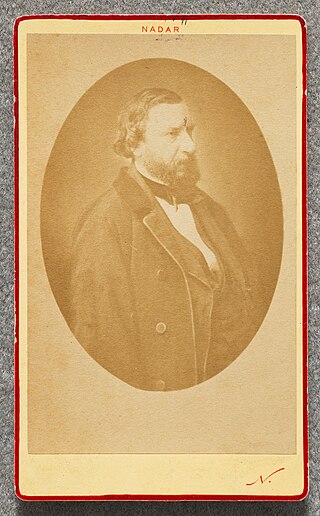
Constant Troyon was a French painter of the Barbizon school. In the early part of his career he painted mostly landscapes. It was only comparatively late in life that Troyon found his métier as a painter of animals, and achieved international recognition.
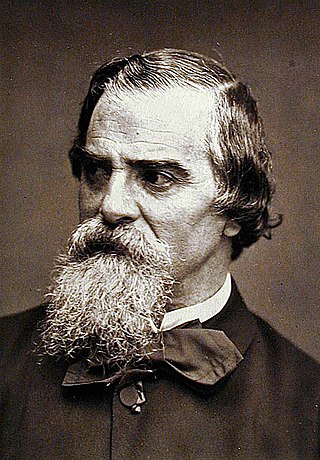
Narcisse Virgilio Díaz de la Peña was a French painter of the Barbizon school.

Étienne Pierre Théodore Rousseau was a French painter of the Barbizon school.
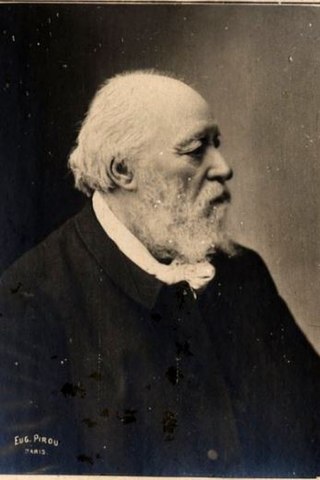
François-Louis Français (1814–1897), usually known as Louis Français, was a French painter, lithographer and illustrator who became one of the most commercially successful landscape painters of the 19th century. A former pupil of Gigoux, he began his career by studying lithography and wood engraving, becoming a prolific illustrator and printmaker. His work as an illustrator is to be found in around forty books and numerous magazines from the late 1830s to the 1860s. Français also produced a large number of pen and ink drawings, enhanced by sepia, notable for their attention to detail and for their technical adroitness and conciseness.

Homer Ransford Watson was a Canadian landscape painter. He has been characterized as the painter who first painted Canada as Canada, rather than as a pastiche of European painting. He was a member and president (1918–1922) of the Royal Canadian Academy of Arts, as well as a founding member and first president (1907–1911) of the Canadian Art Club. Although Watson had almost no formal training, by the mid-1920s he was well known and admired by Canadian collectors and critics, his rural landscape paintings making him one of the central figures in Canadian art from the 1880s until the First World War.

Barbizon is a commune (town) in the Seine-et-Marne department in north-central France. It is located near the Fontainebleau Forest.

Paul Durand-Ruel was a French art dealer associated with the Impressionists and the Barbizon School. Being the first to support artists such as Claude Monet, Camille Pissarro, and Pierre-Auguste Renoir, he is known for his innovations in modernizing art markets, and is generally considered to be the most important art dealer of the 19th century. An ambitious entrepreneur, Durand-Ruel cultivated international interest in French artists by establishing art galleries and exhibitions in London, New York, Berlin, Brussels, among other places. Additionally, he played a role in the decentralization of art markets in France, which prior to the mid-19th century was monopolized by the Salon system.
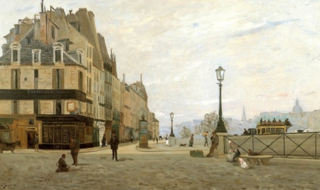
Hippolyte Camille Delpy (1842–1910) was a French painter.
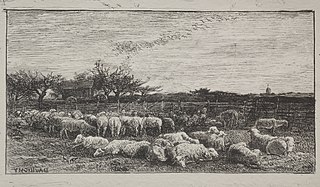
Cliché verre, also known as the glass print technique, is a type of "semiphotographic" printmaking. An image is created by various means on a transparent surface, such as glass, thin paper or film, and then placed on light sensitive paper in a photographic darkroom, before exposing it to light. This acts as a photographic negative, with the parts of the image allowing light through printing on the paper. Any number of copies of the image can be made, and the technique has the unique advantage in printmaking that the design can be reversed just by turning the plate over. However, the image loses some sharpness when it is printed with the plain side of the glass next to the paper.

János Thorma was a Hungarian painter. A representative figure of the Nagybánya artists' colony, which started in 1896, in Nagybánya, Austria-Hungary, he moved through different styles, shifted from the naturalism that was the aesthetic of the colony, to historical subjects, to romantic realism and to a Post-Impressionism style. His work is held by the Hungarian National Gallery, the Thorma János Múzeum, regional museums and private collectors.

Léon Germain Pelouse was a largely self-taught painter born in Pierrelaye, France. His work was most often said to descend from that of Corot and Daubigny, but was from the beginning unique in its depiction of an often stark, obsessively detailed nature largely devoid of human figures. At the time of his death at age 52 in Paris, Pelouse was "considered one of the great landscape painters of his time."

Eugène Lavieille was a French painter.

Albert Heinrich Brendel, who was born in Berlin in 1827, studied in the Prussian Academy of Arts under Wilhelm Krause. In 1851 he went to Paris, and studied under Couture and Palizzi; thence to Italy, and home to Berlin in 1853, completing his studies under Carl Steffeck. For the next ten years he lived mainly in Paris, and worked in the summer months at Barbizon school, in the forest of Fontainebleau, which was also the scene of the labours of Jean-François Millet, Théodore Rousseau, Narcisse Virgilio Díaz, Constant Troyon, and other artists; and he continued, till 1869, to visit Barbison in the summer, after he moved in 1865 to Berlin for the winter. In 1868 he was made a member of the Berlin Academy, and in 1875 became professor at the Weimar Saxon-Grand Ducal Art School. His first works were sea-pieces, but afterwards he devoted himself to animal painting, in which he was very successful. He received medals at various exhibitions at Paris, Berlin, Munich, Vienna, and Nantes. He died in 1895.

Adolphe Appian was a French landscape painter and etcher.
Marie a'Becket was an American painter associated with the American Barbizon school.

Starry Night is an oil-on-canvas painting by Jean-François Millet completed in 1850 and retouched in 1865. One of Millet's few paintings that is exclusively a landscape, it is in Yale University Art Gallery, in New Haven.


























